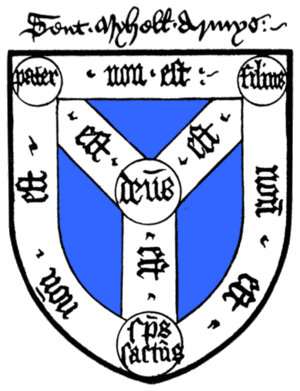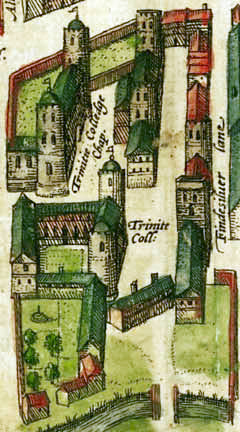Michaelhouse, Cambridge facts for kids
Quick facts for kids Michaelhouse |
|
|---|---|
 |
|
| University | Cambridge University |
| Location | Trinity Street, Cambridge |
| Coordinates | 52°12′25″N 0°07′01″E / 52.207°N 0.117°E |
| Full name | The House of Scholars of St Michael |
| Motto | Panem angelorum manducavit homo (Latin) |
| Motto in English | Man hath eaten the bread of Angels |
| Established | 1324 (merged with King's Hall to form Trinity College in 1546) |
| Named for | The Holy and Undivided Trinity, the Blessed Virgin Mary, St Michael the Archangel and All Saints |
Michaelhouse was an old college at Cambridge University. It existed from 1323 to 1546. Then, it joined with another college called King's Hall to create Trinity College. Michaelhouse was the second college in Cambridge where students lived and studied. The first was Peterhouse, founded in 1284. Today, the name Michaelhouse is used for St Michael's Church in Cambridge.
Contents
How Michaelhouse Started
Michaelhouse was officially started on Michaelmas Day in 1324. It was a college for scholars who were also priests. The college got its name from the nearby St Michael's Church, which was on Cambridge's main street (now Trinity Street).
The Founder
The college was founded by Hervey de Stanton. He was an important person in England, working for King Edward II. He was like the country's money manager and a top judge. Hervey de Stanton started the college between spring 1323 and autumn 1324. He bought land and buildings for the college.
Official Permission
In May 1324, King Edward II gave Michaelhouse a special royal charter. This was like official permission to be a college. The Bishop of Ely, John Hotham, also gave his approval. These official documents allowed Hervey de Stanton to choose the college's first leader, called a Master. On Michaelmas Day that year, Walter de Buxton became the first Master of Michaelhouse.
Growing the College
After Hervey de Stanton died in 1325, others continued to expand the college. They bought more land and buildings near St Michael's Lane (now Trinity Lane) and the River Cam. This area is now part of Trinity College's Great Court.
By the mid-1300s, Michaelhouse covered most of the area where Trinity College's Great Court and New Court are today. The college had a good income, even though its buildings were not huge. By the time it closed, Michaelhouse had an annual income of over £140. This was more than many other important places at the time.
The End of Michaelhouse
Michaelhouse was a place for clergy (church leaders) to study. It had a traditional way of thinking about religion. One famous Master was John Fisher, who led the college from 1497 to 1505. He helped start St John's and Christ's. John Fisher disagreed with King Henry VIII about changes to the church. Because of his strong beliefs, he was executed in 1535.
Ironically, King Henry VIII used his power to close Michaelhouse. After he closed many religious houses in England, Cambridge University worried about its colleges. The university asked Queen Katharine Parr for help. She convinced Henry VIII to save most colleges.
In 1546, Michaelhouse was officially closed by an act of Parliament. It was combined with its neighbor, King's Hall, to form Trinity College. Trinity College later received more money and land from Queen Mary Tudor and Queen Elizabeth I. Today, Trinity College is one of the largest and richest colleges at Cambridge.
Not much of the original Michaelhouse buildings remain today. Its stones were likely used to build the new Trinity College. Some of its old walls are now hidden behind later additions to Trinity's kitchens and dining areas.
St Michael's Church
The church of St Michael is very old, possibly dating back to when Cambridge was first founded. Hervey de Stanton rebuilt the church in the 1300s. He designed it to be used by both the local community and the college. The church has a long main area (nave) and side aisles.
In 1324, Hervey de Stanton suggested that the college's priests could lead daily services for the local people. This was because they already used the church as their chapel. So, the first Master of Michaelhouse, Walter de Buxton, also became the vicar (priest) of St Michael's Church.
A Church for Colleges
The church's main area was used for services, sermons, and university discussions. For a while, Michaelhouse and another college, Gonville Hall, shared the church's side aisles. Gonville used the north aisle, and Michaelhouse used the south.
Michaelhouse priests served the church until the college closed in 1546. After King's Hall Chapel was taken down in 1550, students from the new Trinity College used St Michael's Church as their chapel. They used it until their own chapel was finished in 1565. Some old wooden seats from King's Hall Chapel, made in 1485, were moved to St Michael's. They are still there today.
Trinity College still supports St Michael's Church. For many years, priests from Trinity College served as clergy at St Michael's. The current minister still holds this title.
Church Renovations
From the mid-1600s to the mid-1800s, the church was used for important church meetings and services for the Diocese of Ely. In 1849, the church roof caught fire because of the heating system. George Gilbert Scott helped rebuild the roof and restore the church the next year.
Later, from 1870 to 1872, Scott's son, George Gilbert Scott, Jr., redesigned the church's altar area. He added a beautiful new east window and a tall altarpiece. Local craftspeople and artists worked on these changes. One artist, Frederick Leach, painted the Chancel ceiling and arches for free as a thank-you gift.
Michaelhouse Centre
Over time, the local church community became too small to support the church on its own. St Michael's parish eventually joined with another nearby parish in 1908.
The church was fully renovated in 2001–2002. It is now called the Michaelhouse Centre, Cambridge. It serves as a busy church during the week, a community center, and an art gallery. It also has a café run by a charity. The chapel near Hervey de Stanton's grave is named in his memory. It is still a central place for daily prayers at the church he built so long ago.




